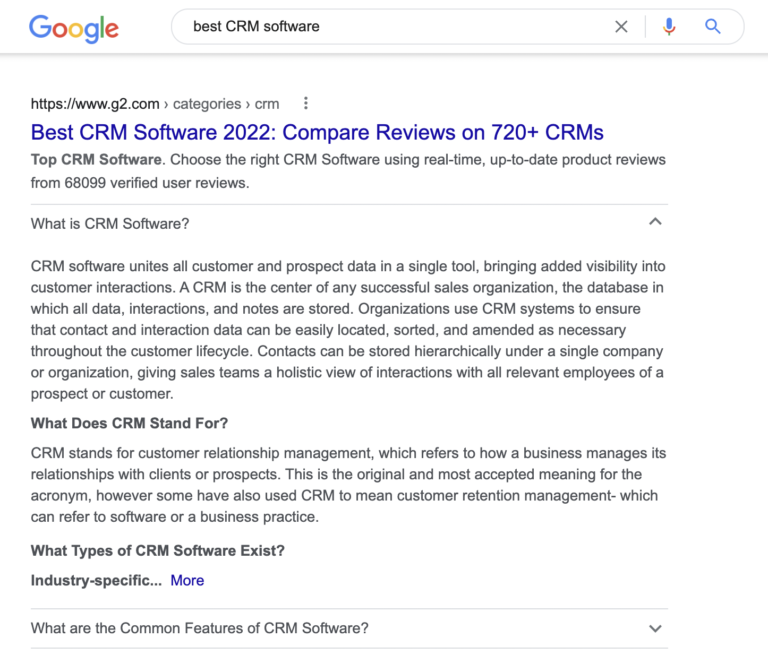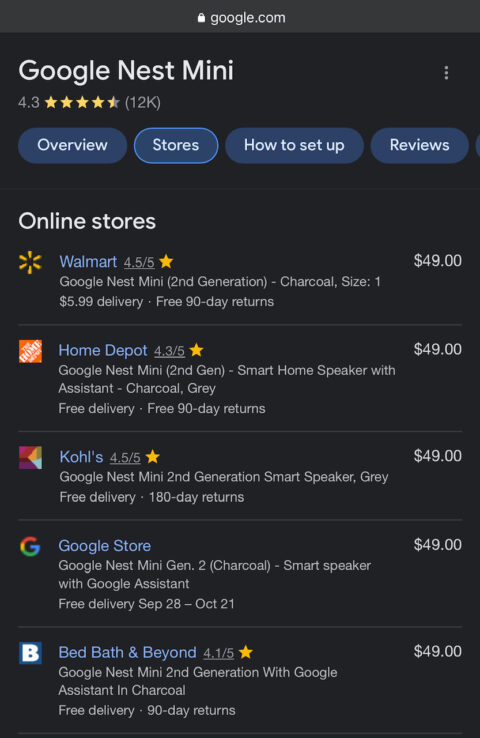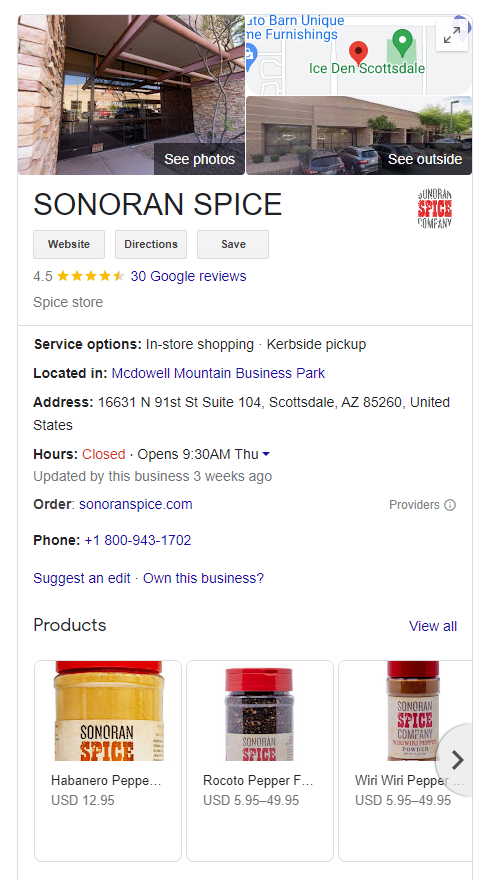Search results have come a long way. A standard organic search result before Google introduced SERP features displayed the title tag, meta description, and URL.
Fortunately, you don’t need to limit your ecommerce store’s organic search performance to this.
Stay one step ahead of your competitors by implementing structured data. It allows you to make your product stand out in search results with product details, pricing, availability, and even shipping times.

How Do Rich Results Apply To Ecommerce?
Google’s rich results are snippets of the content displayed on SERPs (search engine result pages). Rich results can be either a snippet of text or an image with a description.
Search engines can only display rich snippets through structured data on your website.
Structured data uses schema markup, a shared language between search engines, to help them understand your page better, so they can display more accurate information in an engaging way to shoppers in search results.
With the appropriate structured data, merchants will be eligible to have products displayed for sale directly from search results.
Ecommerce-specific rich snippets provide additional information to shoppers about the products you offer straight from the search results pages. This includes price, availability, review summary, description, and more.
Ecommerce rich results don’t end at the product page.
There are essential pieces of schema markup that you can apply to other pages on your site.
As Google states,
“Remember that shoppers may be at different stages in their shopping journey and looking for more than just product pages.”
This article will explore the most critical structured data to apply to your ecommerce store.
What Are Best Practices For Ecommerce Schema Markup
Structured data isn’t going to impact your SEO directly.
It will, however, provide you the best opportunity for rich snippets, which can help improve click-through rates, and conversions, and ultimately, these elements can have a flow-on effect for SEO.
Rich snippets will only show in search results at Google’s discretion. To do so, Google relies on optimal embedded structured data.
Depending on which ecommerce platform you use, structured data markup apps are available to help you do this, such as the JSON-LD for SEO app in Shopify.
Otherwise, you can implement the structured data yourself, following the various guides for your platform.
Best practices for implementing structured data are:
- Only include relevant structured data.
- Focus on the core meaning of the product.
- Use unique identifiers for products.
- Avoid using conflicting or redundant information. Some review apps implement their review schema markup, and this can confuse search engines.
8 Must-Have Ecommerce Rich Snippets
1. Product Snippets
Detailed Product Information To Attract Clicks
As an ecommerce store, products are your bread and butter.
When users are searching for a specific product, it’s helpful to have extra information on display to help them make a more informed decision.
Depending on your industry and product offering, Google may choose to display certain features such as color, size, material, etc, depending on the product markup it can pull from your page.
These are taken on a case-by-case basis, vary according to location, and may not always be shown.
 Image from Google, September 2022
Image from Google, September 2022
To qualify for product rich results, ensure you have the required product markup to quality for product rich results.
Here’s a summary of the most essential ecommerce product markup to drive more clicks and, ultimately, more sales:
- aggregateRating – The average rating for that product.
- brand – The brand associated with the product being offered.
- description – A detailed description of the product on offer.
- image – A full imageObject description https://schema.org/ImageObject or a product photo URL
- gtin – Global Trade Item Number is a unique product identifier such as gtin8 / gtin13 / gtin 14 / mpn / isbn. Google recommends “that you use the most specific GTIN that applies to your product “for the most accurate representation of the product.”
- name – The product name.
- offers – Used for product variants where a price range will display.
2. Reviews Snippets
Showoff Your Glowing Yellow Stars
The only review markup ecommerce stores need to implement on product pages is aggregateRating.
While this review markup technically falls under Product Markup, it’s important to highlight. Review markup for a product page can make or break a product listing in SERPs.
Those yellow stars you see in search results for a product; that’s an aggregateRating rich snippet.
To qualify for aggregateRating rich snippets, you will need live product reviews on your product page, based on the average of these ratings.
Even more reason to gather those glowing product reviews from customers!
 Screenshot from Google, September 2022
Screenshot from Google, September 2022
Trying to manipulate review markup with fake reviews or other spammy review markups can be detrimental to your store. This behavior goes strictly against Google’s policies.
3. Offer Snippets
Make Your Irresistible Offer Stand-Out
Offer markup provides search engines with up-to-date information on price and availability.
These appear below your meta description and can be extremely helpful for customers already at the purchasing decision stage:
- availability – To display whether the product is In Stock, Out of Stock, Preorder, etc.
- price – This must be a specific price and not a range. The offer markup will make you eligible for price drop display rich snippets (if available in your country).
- priceCurrency – The applicable currency your product is being sold in.
- priceValidUntil (in ISO 8601 date format) – The date after which the price is no longer available.
- sku – Your unique Stock Keeping Unit identifier for the product.
- url – The URL of the product page on your website.
- itemCondition – Displays whether the product is being sold as new or used.
4. Breadcrumb Snippets
Help Search Engines Understand Your Page Hierarchy and Improve User Navigation
Think of breadcrumbs as a trail of clicks left behind when navigating to a page on your website. They display in search results in this fashion:
 Screenshot from Google, September 2022
Screenshot from Google, September 2022
BreadcrumbList markup helps crawl-bots understand the hierarchy of pages and display a more accurate trail in search results. It’s helpful for customers to understand the logical categorization of your products and to navigate back and forth between product and category pages.
BreadcrumbList markup needs to include the following to be eligible for display:
- position.
- item.
- id.
- name.
5. Organization Snippets
Gain Credibility And Trust For Your Brand
A search query for your brand will generally (if SEO has been effective) show your store’s homepage in the SERP’s first position.
This may not be the case if you have stockists competing for your branded keywords. You can help your homepage stand out from other results and immediately gain trust and credibility with the help of homepage markup.
- Website – required url, target, query-input.
- Organization – required name, url, description, logo, image, sameAs, address.
Contact information like a telephone number is also helpful here, enabling users to click the link from their mobile device and call you directly from the results page.
6. FAQ Snippets
Take Up More Search Engine Space
Category pages are often the strongest performing pages for ecommerce pages as they tend to attract broader keywords and greater search volumes.
While there aren’t as many opportunities for category page rich results compared to product pages, you can still leverage two primary markups to take up white space in SERP:
 Screenshot from search for [best CRM software], Google, September 2022
Screenshot from search for [best CRM software], Google, September 2022
Google recently explained that FAQ markup is allowed for non-FAQ content.
With FAQs on a page, you can qualify for rich results.
When FAQs are displayed as a snippet, your category page search result will take up more space and stand out.
You also have the opportunity to address some lingering questions potential customers might have about your product offerings.
7. Shipping Snippets
Set Expectations To Help Customers Buy Now
Shipping markup is underutilized and a great way to make your product listing pop.
When a user can view expected shipping costs and times from within search results, it can help them make a faster and more informed buying decision. This also sets realistic expectations around shipping times and creates a better user experience.
 Screenshot from search for [google mini nest], Google, September 2022
Screenshot from search for [google mini nest], Google, September 2022
OfferShippingDetails represents information about shipping destinations. The most helpful markup to display for ecommerce stores is:
- shippingRate – The total cost a user can expect to pay to their destination for their order.
- deliveryTime – Displays the time it takes between when an item is ordered and received by the customer.
8. Location Snippets
Make Your Mark On The Map
If your ecommerce store also has a physical location, inventory location data can be powerful for helping Google show your inventory availability for product “near me” queries.
A Google Business Profile listing is needed to display rich location information.
This can then display a beautifully detailed view of your store and a summary of your offerings in search results.
 Screenshot from Google, September 2022
Screenshot from Google, September 2022
How To Validate Structured Data
To help improve the accuracy of your rich snippets when being displayed, provide Google with accurate structured data. In return, they’re more likely not to make a mistake when they automatically extract it.
There are many ways to validate structured data and check for errors, including using Validator Schema.
The simplest method is to use the Rich Results Test Tool.
To test whether product markup is displaying, check the page using the URL inspection tool in Google Search Console to ensure it’s being indexed.
There is so much untapped potential in achieving ecommerce rich snippets.
By implementing the appropriate schema markup, you will give your store the best opportunity to earn rich results and stand out from the competition.
More resources:
Featured Image: Roman Samborskyi/Shutterstock
window.addEventListener( ‘load’, function() {
setTimeout(function(){ striggerEvent( ‘load2’ ); }, 2000);
});
window.addEventListener( ‘load2’, function() {
if( sopp != ‘yes’ && addtl_consent != ‘1~’ && !ss_u ){
!function(f,b,e,v,n,t,s)
{if(f.fbq)return;n=f.fbq=function(){n.callMethod?
n.callMethod.apply(n,arguments):n.queue.push(arguments)};
if(!f._fbq)f._fbq=n;n.push=n;n.loaded=!0;n.version=’2.0′;
n.queue=[];t=b.createElement(e);t.async=!0;
t.src=v;s=b.getElementsByTagName(e)[0];
s.parentNode.insertBefore(t,s)}(window,document,’script’,
‘https://connect.facebook.net/en_US/fbevents.js’);
if( typeof sopp !== “undefined” && sopp === ‘yes’ ){
fbq(‘dataProcessingOptions’, [‘LDU’], 1, 1000);
}else{
fbq(‘dataProcessingOptions’, []);
}
fbq(‘init’, ‘1321385257908563’);
fbq(‘track’, ‘PageView’);
fbq(‘trackSingle’, ‘1321385257908563’, ‘ViewContent’, {
content_name: ‘ecommerce-rich-snippets’,
content_category: ‘ecommerce seo’
});
}
});


